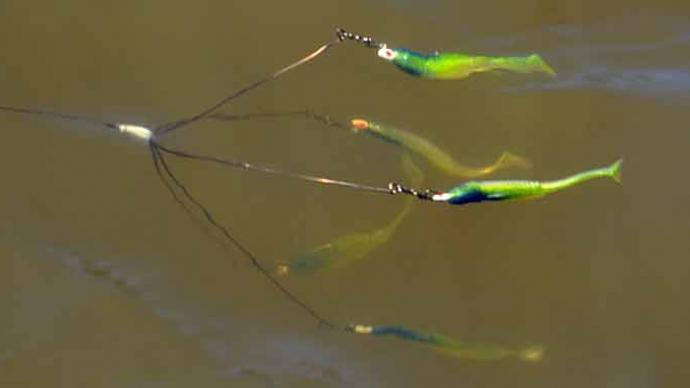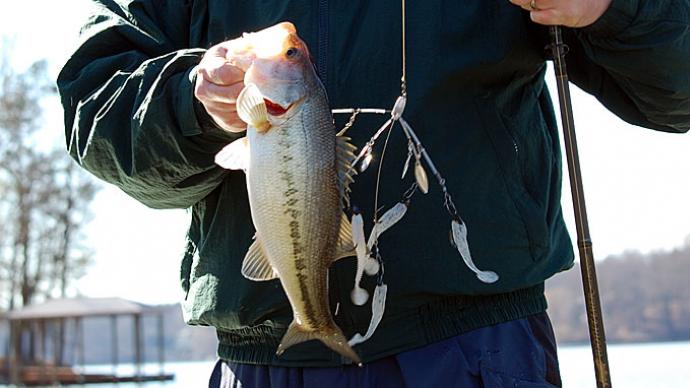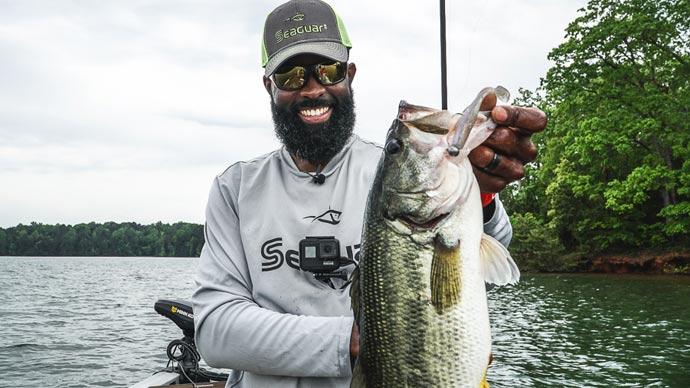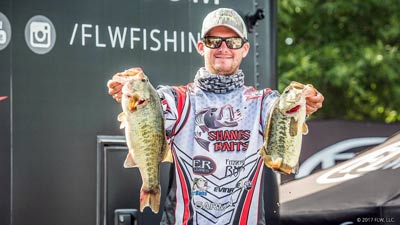
Fly anglers, especially those that chase trout, live by one rule above all others; every lure they tie to the end of their line must closely mimic what the fish are eating, whether it’s an insect, baitfish, or some other aquatic creature. That’s easy when working in the world of small hooks, thread, fur, and feathers.
That rule doesn’t apply to umbrella rigs at first glance. They are massive, adorned with three to nine wires, each leading to a swimbait. They make a big splash when hitting the water and push plenty more throughout the retrieve. Every bass in the vicinity of one knows that it is there. The strikes it produces are pure reaction, so it wouldn’t seem to make much difference in which swimbait you attach to each arm. But, that’s not the case, according to FLW Tour pro Shane Lehew.
Lehew lives in Catawba, N.C., not far from Lake Norman and other popular Catawba River reservoirs. All of these are great places to fish umbrella rigs. They are full of clear water where bass chase big schools of shad year-round. He cut his fishing teeth and racked up bass tournament accolades, including the 2007 Bass Federation National Junior World Championship, a T-H Marine BFL win in 2009, and two college fishing wins in 2013. He launched his FLW Tour pro career in 2014, having fished the two prior seasons as a co-angler.
But Lehew’s on-the-water accomplishments aren’t the only reason he is knowledgeable when selecting swimbaits for umbrella rigs. He operates Shane’s Baits, selling a variety of umbrella rigs that he designed and continues to build. His are unique because each arm can be replaced after being bent by too many encounters with fish. And most, like his popular Blades of Glory, incorporate willow leaf blades for added attraction. There’s even one that uses buzzbait blades, a unique choice for schooling bites.
Once Lehew chooses his umbrella rig, he selects swimbaits based on size, color, and rigging. When you select any style of lure, the perfect one depends on where you are fishing. Even the bass species — largemouth, smallmouth, or spotted — factor into your choice. Combine all those variables with an almost endless selection of colors and sizes, and picking one can become a daunting task. But, it doesn’t have to if you follow Lehew’s advice.
Perfect profile

Most of the forage in Lehew’s home lake are threadfin shad. They grow to about 3 inches long and travel in large schools. He imitates them and other small baitfish, such as perch, that he might be fishing around, with swimbaits 3 1/2 inches or shorter. He doesn’t worry about only catching small bass with these small baits. He’s caught several bass between 7 and 9 pounds on them.
Lehew continues to match the threadfin hatch by tying on one of his namesake nine-arm umbrella rigs. “It just looks like a school of baitfish,” he said. While the legality of using that many lures depend on where you are fishing, it’s good to go in his home state.
Lehew takes a different approach when fishing lakes with larger prey, such as Clarks Hill Lake, which South Carolina and Georgia share. There, blueback herring, which can grow to about 1 foot, is what bass eat most. To match the hatch on these lakes, he reaches for swimbaits that measure at least 4 to 5 inches long.
Larger profile swimbaits push more water than smaller ones, and that extra disturbance helps bass find them when the water is stained or even muddy. “I’m not afraid to throw [an umbrella rig] in dirty water,” Lehew said. “They have no problem finding it in dirty water.” He only requires 1 foot of visibility to pick one up. “We make one with eight blades on it,” he said. “That’s a lot of flash. It’s a super big profile.”
But while the size of his swimbait increases on fisheries with larger baitfish, he decreases the number of arms on his umbrella rig. Going with three, for example, decreases overall weight, making casting easier.
One thing all your umbrella rig swimbaits should have in common is an aggressive tail. It should be boot-shaped and as close to perpendicular to the lure’s body as possible. That will ensure that it catches plenty of water, which creates its action.
Perfect color
Once Lehew determines the perfect size swimbait for his umbrella rig, he needs to settle on a color.
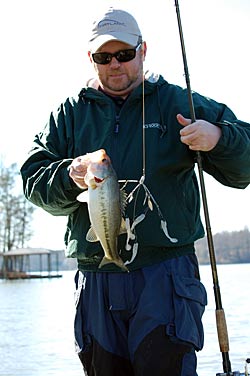
“Clear water demands a lifelike swimbait,” Lehew said. Shad or translucent with purple or green flakes are his first choices. Those give his lures some flash without being overpowering. “I like to make it as natural as possible,” he said. “Tennessee shad is one of my favorites.”
Lehew does as most anglers when the water is dirty and chooses a brightly colored lure. His first choice is white.
No matter what color he chooses and how many swimbaits his umbrella rig sports, Lehew makes sure they all match. “I’ve never looked down on a school of shad and seen nine different colors,” he said. “Most of them are about the same. So, I keep them the same.”
Lehew has one more color change he likes to make, thanks to a tip he picked up while watching “Zona’s Awesome Fishing Show.” At least in some situations, he’ll dye the swimbait tail that sticks the farthest back on his umbrella rig a bright color. “Spots, smallies and mean mouth — hybrids of smallmouth and spots or largemouth — like that bright stuff,” he said. “Largemouth aren’t apt to react to that unless the water is dirty.”
Perfect rigging
Lehew uses several factors to determine how he rigs his swimbaits. The first is the amount of cover. If it’s lacking or sparse, he goes with his favorite method. “If I can get away with it, I’m running open hooks,” he said. Those are attached to a lightweight jig head — 1/16 ounce — in sizes 2/0 to 5/0. He chooses the size that matches the swimbait he is using. The hook should emerge just past the midpoint of the lure’s back. Any farther, and it can trip up the tail’s action.
Like its hulking size, there’s nothing delicate about how bass strikes an umbrella rig. They move fast, hoping for a large amount of carnage as they plow through what appears to them as a school of baitfish. “Their instinct is to kill that baitfish then turn around and eat it,” Lehew said. “It’s going to try and run through there, grab as many as possible, and turn around and sit somewhere.” At times that can mean hooking bass outside the mouth. But that happens just as often when fishing a jerkbait, he said.
There are times beyond fishing around brush or aquatic vegetation when Lehew doesn’t want open hooks on his umbrella rig, especially when he is fishing the nine-arm rig. With that many baits swimming along, the ones on top can get tangled with those below, ruining your presentation. Texas rigging those on top solves that problem.
While Lehew enjoys cashing in on an umbrella rig’s bass-catching power just as much as other anglers, he does make one more adjustment that most don’t. Instead of 60- or 65-pound test braided line, he used 20- or 25-pound fluorocarbon line. Its larger diameter makes his umbrella rig sink slower. It also is easier to straighten out when you get a backlash, which isn’t uncommon when trying to cast so much weight. “If you ever kink braid, it’ll stop the spool,” he said. “And you’ll probably throw that rod down in the boat.”


